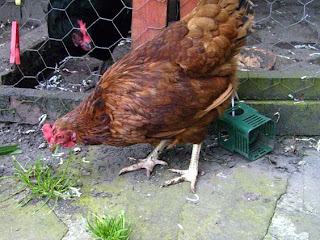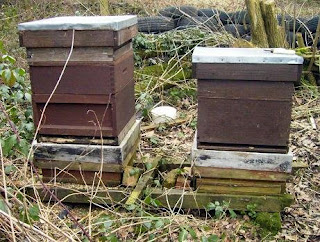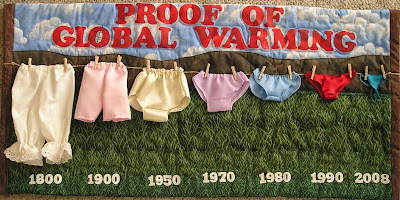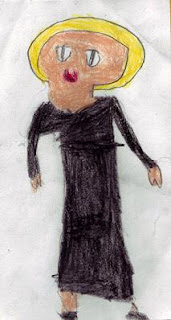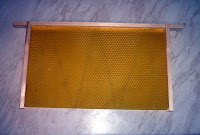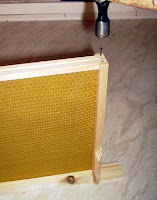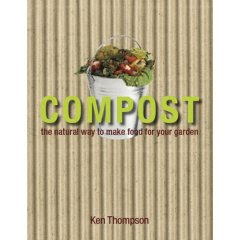
The first thing that strikes you about
Compost by Ken Thompson is the groovy cover. I mean literally groovy. It feels like it has been made out of corrugated card. It's striking and eye catching, which is exactly what you'd expect of a book by Dorling Kindersley.
When you open the book, your expectations are not disappointed. The photographs, the graphics, the typesetting, everything about this book is beautiful. It's even more of an achievement when you consider the subject matter: if you had to create a book about decomposing vegetables, worms, poo, bacteria and fungi, could you make it a feast for the eyes?
But what about the content? To be honest, I'm in two minds. DK books are always visually stunning, but sometimes they can be rather shallow when it comes to content. This book is a bit like that. Any page you flick open you will find a full-page photo on one side and a few lines of enormous text facing it. It took me about an hour to read it cover-to-cover. And although it did contain a few things I didn't know (apparently a human corpse decomposes to a skeleton in about three weeks), there wasn't much (and even that wasn't terribly useful. I hardly ever put human corpses on my compost heap).
But on the other hand, I've read books on compost that went into so much science and detail about aerobic and anaerobic, thermophilic and mesophilic, exact recipes for the perfect compost heap, how frequently to turn it, the correct moisture content and so on, that it would put any sensible person off the idea of composting altogether. And that's silly, because as Thompson quite rightly says:
Even if you do everything wrong, you will still make decent compost eventually.
(only he says it in 197pt text).
This matches my experience perfectly, and it also matches common sense. It makes me laugh when people say things like "You can't put avocado peel on the compost heap. You can't put orange peel or any citrus on it." Of course you can. Orange peel decomposes perfectly well. I've got a decomposing orange in my fruit bowl at this very minute (I really should chuck it on my compost heap). Otherwise we'd all be neck deep in perfectly preserved avocado and lemon peels that would have been accumulating since the evolution of avocado and citrus trees. Getting stuff to decompose isn't hard. Stopping it decomposing is hard, but making compost is not hard.
So I liked Thompson's sensible, relaxed attitude. There's a chapter where he describes the standard "recipe" for perfect compost. You know the one: collect together at least a cubic metre of equal amounts of "green" (soft, nitrogen-rich material such as veg peelings and grass clippings) and "brown" (dry, carbon rich material such as shredded paper and hedge prunings). Layer them in six-inch thick layers. Ensure there is just enough water. Turn once a week. And so on. Then Thompson rips into this recipe with satisfying ridicule and sarcasm. Where are you supposed to store all this green and brown material whilst you're waiting until you've collected enough? How do you stop it decomposing in the meantime? Keep it in the fridge? Forget that, just decide where you want your heap then bung compostable stuff on it as and when it becomes available. There's no need at all to follow a precise recipe. It's a compost heap, not a damn souffle.
If you've never made compost, you might like this book. Especially if you're scared of compost-making for some reason, perhaps because you've read one of those silly books with too much science and prescriptive instructions. Ken Thompson's books is guaranteed to remove the fear and assure you that compost-making is easy and worthwhile. If you're an experienced composter, you don't need this book. Actually, you don't need any book, because all you really need to know about compost is this: 1) Put organic stuff in a heap. 2) Wait. And that's all that Thompson says, but with better pictures.
 On one of the allotment plots I found this Buddha head, nestling among a row of onions. The plot belongs to a white-haired cloth-capped Mancunian gent, who I would not have suspected of being a closet Buddhist. When I asked him about it he told me "it just turned up one day", and he rather liked it, so he set it among his onions.
On one of the allotment plots I found this Buddha head, nestling among a row of onions. The plot belongs to a white-haired cloth-capped Mancunian gent, who I would not have suspected of being a closet Buddhist. When I asked him about it he told me "it just turned up one day", and he rather liked it, so he set it among his onions.





